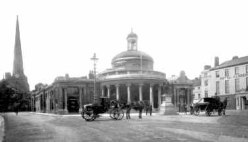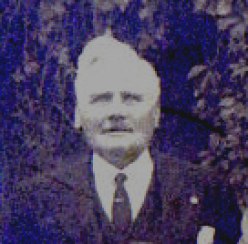A small Industrial Somerset Town
The population of Bridgwater in 1938 was some 18,000. The depression was hitting this labour-intensive rural backwater, and although its port was ticking over satisfactorily, the traditional brickmaking industry was in serious decline. Unemployment topped 2,000, and the shining hope on the horizon was the nearly- completed Cellophane factory which was just being built.
The boundaries of the town were about to be expanded with 2 major new estates in Sydenham. The streets around Mansfield Park were about to be renamed (King George, York, Gloucester) in an attempt by the right-wing town council to inject some deference and support for the monarchy into the historically rebellious townsfolk.
To the West of the town, the slum courts extended from Penel Orlieu into West street, but then gave way to the middle-class areas on the Durleigh road, Northfields and the Wembdon road. Meanwhile, in the area beyond the Docks, new council houses were being constructed around Kendale road – the street named after the very first Mayor of Bridgwater.
The Town Council was controlled by an elderly and time-serving middle-class Liberal-Tory ‘civic-arrangement’. Small businessmen from traditionally-influential local families called themselves ‘Independents’ to avoid the charge that political allegiance might cloud their civic duty, and ruled the town in their own interest.
Wealthy Tories included William Oscar Coates – the Elms, Wembdon, Robert Marquis – the Grange, Durleigh, Charles Luckes, of Wanganui, Bawdrip and Major Akerman.
High (neo-whig) Liberals included Louis Henry Palmer 30 Northfield,Bridgwater. William Pitman 115 Durleigh rd, respected Solicitor Harold Scholfield and popular Eastover Tobacconists Mr and Mrs Reed.
On the opposite side of the council chamber was a strong and vocal Labour opposition, including insurance agent Harry Goodman – 7 Ashleigh Terrace, Jim Boltz 55 Bristol Rd, Walt Farthing 21 Blacklands – who started out as a basket maker and the newly elected Les Gray – a brickie of 1 Ashleigh Avenue – sometimes joined by the nominally independent left-leaning ‘co-op’ man Maurice William Woodbury (whose name adorns the main road through the present day Co-Op estate). It was to be Woodbury’s downfall at the ’38 election that he used the slogan “use anybody’s car but vote Woodbury” which brought him considerable criticism and maybe lost him his seat!
A far-flung constituency with a town and country divide
“…Stretching from Alfred’s Athelney to Lorna Doone Valley” as the Times put it at the time… in fact, the Bridgwater constituency spread out across the southern shore of the Bristol channel from Burnham and Highbridge to Porlock and Exmoor, with some 45,000 voters – of whom only 13,000 lived in Bridgwater.
This area had largely returned Conservative or Liberal MPs – by now largely indistinguishable – but hotly contested elections based on a town and country divide hid a rivalry going back to the English Civil war and maybe even the Peasants Revolt.
The town of Bridgwater was largely left-leaning with its non-conformist religious tradition and later its industrial and trade union base, while the country areas were solid Tory with their powerful landowners, farming dynasties, tied cottages, retired colonels and a comfortably-off middle-class living in the leafy suburbs.
The ‘Blue Poldens’ were as unsafe for a socialist to venture canvassing as Union Street was for a Tory.
At the last election, in 1935, the Tories retained control as they had in 1931, 1929 and 1924, with Liberals and Labour almost equally sharing the opposition votes even as Liberal influence declined in the face of the rising strength of the Labour movement.
| Croom Johnson | (Conservative) | 17,939 |
| Blake | (Liberal) | 7,370 |
| Loveys | (Labour) | 6,240 |
A tradition of militancy
Bridgwater has a proud rebel history going back as far as the days when the area was a centre of guerilla resistance to Danish occupation, and the last hope for an kndependent England under Alfred the Great.
In 1381, Bridgwater people joined the Peasants Revolt and in 1399 the Western Rebellion, taking up arms against the feudal system when many parts of the country acquiesced.
During the English Revolutions of the 17th Century, Bridgwater was on the side of change in the Civil war and declared for Parliament – her most famous son ‘Robert Blake’ being the commander of the navy of the English Republic.
In 1685, Bridgwater joined the Monmouth Rebellion in an effort to overthrow the tyrant James II, but suffered defeat at the battle of Sedgemoor and brutal murderous repression and transportation thereafter.
In 1795 Bridgwater was the first place in the country to petition against the evils of the Slave Trade.
By the end of the 19th century, Bridgwater – now heavily industrialised for a small rural town – had taken to Trade Union militancy. During one Brickyard Strike in 1896 the Mayor, Henry Pollard, had chosen to call in the Army to clear the strikers from the streets at bayonet point, as they surrounded the council and the entire county police force in the Town hall.
In 1926 Bridgwater played its full part in the General Strike, and by the 1930s was a bastion of Trades Unionism and a strongly-placed Labour Party, with at least a militant folk memory under its belt.





